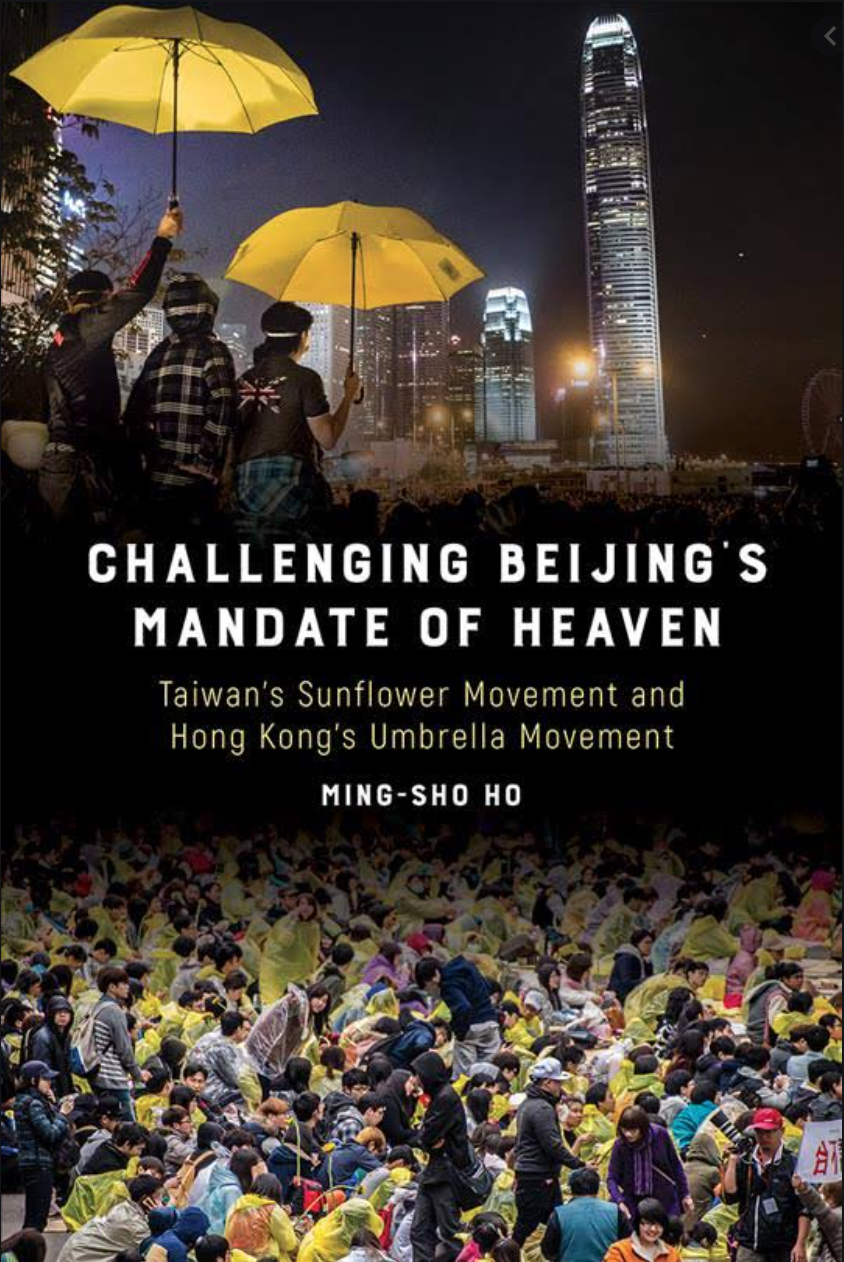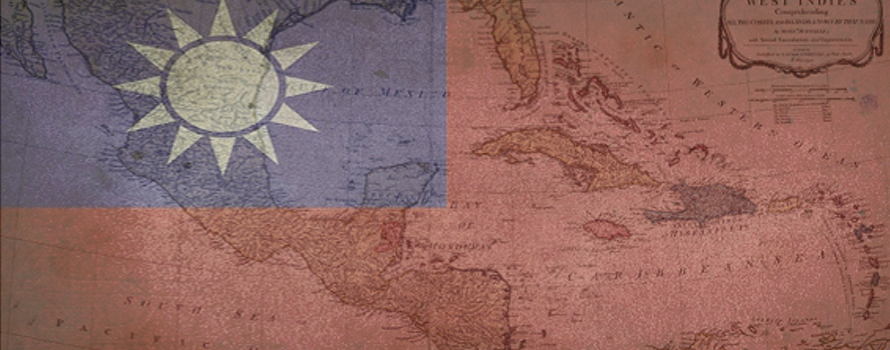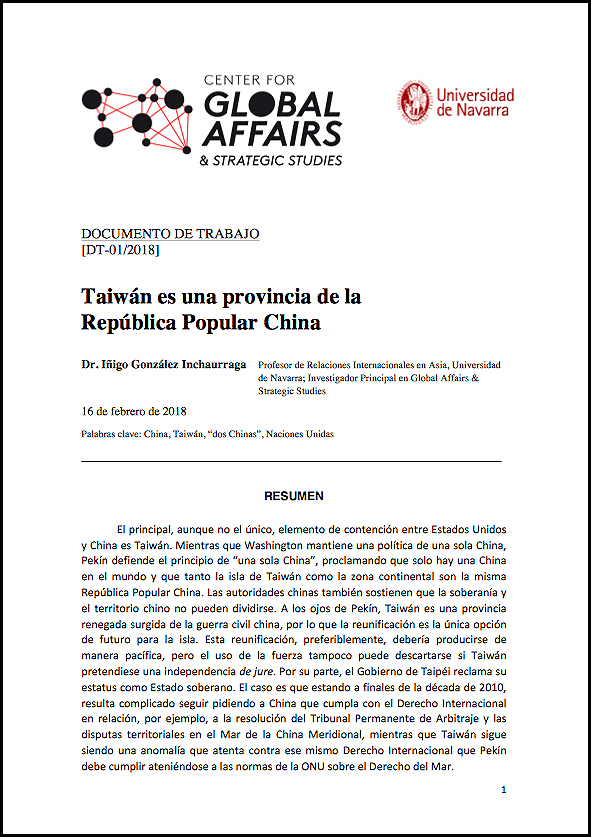Ruta de navegación
Blogs
Entries with label taiwan .
[Ming-Sho Ho, Challenging Beijing's Mandate of Heaven. Taiwan's Sunflower and Hong Kong's Umbrella Movement. Temple University Press. Philadelphia, 2019. 230 p.]
review / Claudia López
 Taiwan's Sunflower Movement and Hong Kong's Umbrella Movement achieved international notoriety during 2014, when they challenged the Chinese regime's 'Mandate of Heaven', to use the image that gives degree scroll to the book. The book analyses the origins, processes and also the outcomes of both protests, at a time of consolidation of the rise of the People's Republic of China. Challenging Beijing's Mandate of Heaven provides a detailed overview of where, why and how these movements came into being and achieved relevance.
Taiwan's Sunflower Movement and Hong Kong's Umbrella Movement achieved international notoriety during 2014, when they challenged the Chinese regime's 'Mandate of Heaven', to use the image that gives degree scroll to the book. The book analyses the origins, processes and also the outcomes of both protests, at a time of consolidation of the rise of the People's Republic of China. Challenging Beijing's Mandate of Heaven provides a detailed overview of where, why and how these movements came into being and achieved relevance.
Taiwan's Sunflower Movement developed in March and April 2014, when citizen demonstrations protested against the approval of a free trade agreement with China. Between September and December of the same year, the Umbrella Movement staged 79 days of protests in Hong Kong demanding universal suffrage to elect the highest authority in this enclave of special status within China. These protests attracted international attention for their peaceful and civilised organisation.
Ming-Sho Ho begins by describing the historical background of Taiwan and Hong Kong from their Chinese origins. He then analyses the status of the two territories so far this century, when Taiwan and Hong Kong have begun to face increased pressure from China. It also reviews the similar economic circumstances that produced the two waves of youth revolts. The second part of the book analyses the two movements: the voluntary contributions, the decision-making process and its improvisation, the internal power shift, the political influences and the challenges of the initiative. The book includes appendices with the list of Taiwanese and Hong Kong people interviewed and the methodology used for the analysis of the protests.
Ming-Sho Ho was born in 1973 in Taiwan and has been a close observer of the island's social movements; during his time as a student of doctorate in Hong Kong he also closely followed the political discussion in the former British colony. He is currently researching initiatives for promote renewable energy in East Asian nations.
Being from Taiwan gave him access to the Sunflower Movement and allowed him to build close relationships with several of its key activists. He was able to witness some of the students' internal meetings and conduct in-depth interviews with students, leaders, politicians, NGO activists, journalists and university professors. This provided him with a variety of sources for his research.
Although they are two territories with different characteristics - Hong Kong is under the sovereignty of the People's Republic of China, but enjoys autonomy management assistant; Taiwan remains independent, but its statehood is challenged - both represent a strategic challenge for Beijing in its consolidation as a superpower.
The author's sympathy for these two movements is obvious throughout the book, as is his admiration for the risk taken by these student groups, especially in Hong Kong, where many of them were convicted of 'public nuisance' and 'disturbing the peace' and, in many cases, sentenced to more than a year in prison.
The two movements had a similar beginning and a similar development beginning, but each ended in a very different way. In Taiwan, thanks to the initiative, the free trade agreement with China failed and was withdrawn, and the protesters were able to call hold a farewell rally to celebrate this victory. In Hong Kong, police repression succeeded in stifling the protest and a final massive raid brought a disappointing end for the protesters. However, it is possible that without the experience of those mobilisations, the new student reaction that throughout 2019 and early 2020 in Hong Kong has put the highest Chinese authorities on the ropes would not have been possible.
Taiwan imports up to four times more than China from Central American countries that recognize it as a state.
Of the almost two hundred countries in the world, only 19 have diplomatic relations with Taiwan (and therefore do not have diplomatic relations with China). Of these, five are in Central America and four in the Caribbean. The recognition of Taipei has some advantages for these countries, although they have been neutralized by China's commercial weight. Panama established relations with Beijing in 2017 and the Dominican Republic has just done so now. Here we examine the interest that preference for Taiwan still holds for certain Central American countries.

article / Blanca Abadía Moreno
Taiwan's special relationship with Central America dates back to the period following Taiwan's 1971 departure from the United Nations, where Nationalist China was displaced by the People's Republic of China. Several Latin American countries had established relations with Taiwan in the 1960s, but most of them gradually came to recognize Beijing after the UN change. Taiwan retained, however, the support of the Central American nations and in the 1980s also gained the support of small Caribbean islands that then became independent.
The emergence of China as a major international trade partner has been subtracting diplomatic recognition from Taiwan. Costa Rica established full ties with China in 2007, Panama in 2017 and the Dominican Republic last May 1. Even so, of the 19 countries that continue to opt for Taipei over Beijing, five are in Central America: Guatemala, Belize, Honduras, El Salvador and Nicaragua (this country with a five-year hiatus, from 1985-1990). Four others are in the Caribbean: Haiti and three tiny nations in the Lesser Antilles. If one takes into account that the rest of the countries that recognize Taiwan are of little commercial importance, except for Paraguay (they are the Vatican, Burkina Faso, Swaziland and six Polynesian microstates), it is understandable that Central America absorbs Taiwan' s diplomatic interest.
Since the constitutive theory of statehood defines a state as a person in international law if, and only if, it is recognized as sovereign by others, Taiwan strives to ensure that those countries continue to recognize it as a subject of plenary session of the Executive Council law in the concert of nations; losing their support would directly affect the legitimacy of its claims as a sovereign state.
To this end, Taipei promotes trade relations with them, procures investments and uses what is called "checkbook diplomacy": submission of gifts (and bribes) to maintain these relations. Central American countries receive an average of $50 million annually in declared non-reimbursable cooperation. Taiwan directs financial aid to its Latin American partners through the development and International Cooperation Fund(ICDF), with programs ranging from infrastructure construction to coffee production. Taiwan has financed and constructed several government buildings in Nicaragua and El Salvador.
In addition, the Asian nation contributes to programs of the Central American Bank for Economic Integration (CABEI) and is an observer country in the Central American Parliament and other regional organizations.
This effort, however, has not prevented that in recent years there have been casualties among Central American countries that saw him giving diplomatic recognition. Costa Rica's economic development led the country in 2007 to want to improve its trade figures through a rapprochement with China, which involved the opening of an embassy in Beijing and the closure of the one it had in Taipei. For the same reason, Panama also opted in 2017 to break off diplomatic relations with Taiwan, stating that China, a prominent Username of the Panamanian canal, "has always played a relevant role in Panama's Economics " and any restrictions preventing it from remaining so had to be removed.
 |
Commercial relations
Trade relations between Taiwan and the Central American countries that recognize it as a State increased significantly thanks to the opening of the Central American Trade Office(CATO) in Taiwan in 1997, the incorporation of this country into CABEI and the entrance entry into force of several trade agreements. Taiwan signed free trade agreements with Guatemala (2006), with Honduras and El Salvador (2006) and with Nicaragua (2008).
These treaties have especially facilitated Central American exports to Taiwan. As is the case with most Latin American countries, Guatemala, El Salvador, Honduras and Nicaragua have China as one of the main origins of their imports (the first is still the United States). Their political alignment with Taiwan does not prevent them from being customers of Chinese production. Thus, in 2016, China ranked between 2nd and 3rd as a source market, while Taiwan ranked far down the table (between 14th and 23rd). However, the special relationship with Taipei means that Taiwan equals or surpasses China as a destination for the exports of the four Central American countries mentioned. This is the commercial benefit they obtain from the diplomatic recognition of the Asian island.
Of this group of countries, Nicaragua exported the most to Taiwan in 2016 (US$83.7 million) compared to exports to China (US$21.5 million), a ratio of four to one. The main Nicaraguan products exported were shrimp, sugar, beef and coffee.
Honduras exported US$24.7 million to Taiwan -mainly textiles, coffee and aluminum- compared to US$18.5 million to China. El Salvador sent shipments to Taiwan worth US$53.3 million - mainly sugar - and US$46.5 million to China. Guatemala, whose Economics has a larger volume, was the only country to sell more to China (75.5 million), but in figures very similar to those of Taiwan (74 million), to which it sent mainly coffee, paper and cardboard.
With these diplomatic and commercial relations Taiwan intends to show international society that it is a capable ally and manager for international cooperation. It also wants to show the world that Taiwanese diplomacy exists despite China's attempts to isolate it. The fact that China has a special interest in markets that facilitate access to raw materials makes the Asian giant more attentive to relations with several South American countries, rich in minerals; it is there where Beijing concentrates its Latin American investments.
Central America, with less extractive activity, thus escapes China's priority (the interest in the Panama Canal is a case apart), and is left for the time being to Taiwan's action. However, the increasingly residual nature of support for the island and the very weight of relations with China suggest that the Central American countries will continue to join this particular club, one after the other, from leave.
DOC. DE work / Iñigo González Inchaurraga
SUMMARY
The main, though not the only, element of contention between the United States and China is Taiwan. While Washington maintains a one-China policy, Beijing defends the "one China" principle, proclaiming that there is only one China in the world and that both the island of Taiwan and the mainland are the same People's Republic of China. The Chinese authorities also maintain that Chinese sovereignty and territory cannot be divided. In Beijing's eyes, Taiwan is a renegade province that emerged from the Chinese civil war, so reunification is the only option for the island's future. This reunification should preferably take place peacefully, but the use of force cannot be ruled out if Taiwan were to seek de jure independence. For its part, the government of Taipei claims its status as a sovereign state. The fact is that at the end of the 2010s, it is difficult to continue asking China to comply with international law in relation, for example, to the Permanent Court of Arbitration ruling and territorial disputes in the South China Sea, while Taiwan remains an anomaly that violates the same international law that Beijing must comply with in accordance with UN rules on the Law of the Sea.
 download the complete document [pdf. 432k]
download the complete document [pdf. 432k]
